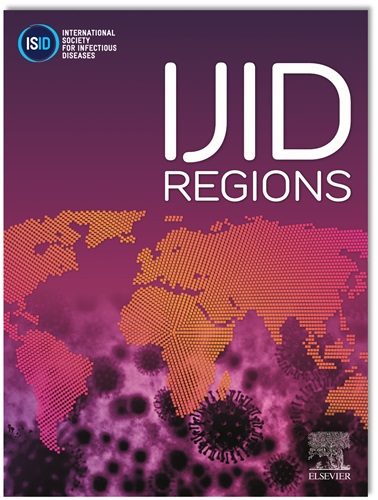Cholera case trends in Eastern Africa using surveillance data, 2007-2024
IF 4.8
2区 医学
Q1 INFECTIOUS DISEASES
引用次数: 0
Abstract
Introduction
Cholera is a public health threat in Africa, with an estimated 68,480 cases and 895 deaths reported across seven of 14 Member States in the Eastern region in 2023. Within the region, cholera outbreak has been protracted in the horn of Africa, with countries responding to the outbreak amid prolonged harsh drought, floods and complex humanitarian emergencies. In recent months, an upsurge in cases and deaths has been observed in the region, with five countries reporting active outbreaks this year. We describe the trend of cholera cases in Comoros, Ethiopia, Kenya, Somalia and Tanzania for 2007-2024.
Methods
Descriptive trend analysis of cholera case data for Comoros, Ethiopia, Kenya, Somalia and Tanzania, from 2007-2024, was performed. Data were obtained from the Event Management System of the Africa Centres for Disease Control and Prevention (2023-2024) and the Global Infectious Disease and Epidemiology Network (GIDEON) online resource for data (2007-2022). Water, Sanitation and Hygiene (WASH) data was sourced from WHO/UNICEF Joint Monitoring Program for WASH. The term 'cholera case' includes both confirmed and suspected.
Results
From 2007 to 5 April 2024, a total of 578,449 cholera cases and 8,514 deaths [case fatality rate (CFR): 1.5%] were reported from Comoros, Ethiopia, Kenya, Somalia and Tanzania. Somalia accounted for 55.2% (315,972) of the cases and 54.6% (4,700) of the corresponding deaths. The average CFR per year was 1.4%, ranging from 0.3% in 2014 to 2.4% in 2016. During the review period, notable geographical patterns that were triggered by climate change were observed. Somalia experienced annual cholera outbreaks beginning November and December and receding in May, with largest occurrences in 2011 (77,636 cases) and 2017 (75,414 cases). Widespread outbreaks occurred in Ethiopia from 2007-2010, with a high peak in 2009 (31,509 cases) and recently in 2023 (29,869 cases). For this year, cases in Kenya appear to be on the decline while Tanzania shows an increasing pattern. Comoros reported its first cholera outbreak since 2007 in February 2024 through a cross-border event with Tanzania. Ethiopia is among countries in Africa with the largest population practicing open defecation in 2022.
Discussion
The trend analysis underscores the persistent nature of cholera outbreak in the Eastern region. Climate change impacts the dynamics of the outbreak by limiting access to safe water and sanitation, and triggering increased cross-border movements. The average CFR per year surpassed the recommended <1% threshold.
Conclusion
The cholera response requires a regional multi-sectoral and coordination mechanism approach, given the same protracted nature and cross-border transmissions. Significant resources are needed to implement long-term WASH strategies. With the predicted above-normal rainfall for the horn of Africa between March and May 2024, climate change in relation to health outcomes should be considered an emerging area of focus.
2007-2024年使用监测数据的东非霍乱病例趋势
霍乱是非洲的一项公共卫生威胁,2023年东部区域14个会员国中有7个国家报告了68 480例病例和895例死亡。在该区域内,非洲之角的霍乱疫情持续时间较长,各国在长期严重干旱、洪水和复杂的人道主义紧急情况下应对疫情。近几个月来,该区域的病例和死亡人数激增,今年有五个国家报告了活跃的疫情。我们描述了2007-2024年科摩罗、埃塞俄比亚、肯尼亚、索马里和坦桑尼亚的霍乱病例趋势。方法对科摩罗、埃塞俄比亚、肯尼亚、索马里和坦桑尼亚2007-2024年霍乱病例数据进行描述性趋势分析。数据来自非洲疾病控制和预防中心事件管理系统(2023-2024年)和全球传染病和流行病学网络(GIDEON)在线数据资源(2007-2022年)。水、环境卫生和个人卫生(WASH)数据来自世卫组织/联合国儿童基金会WASH联合监测规划。“霍乱病例”一词包括确诊病例和疑似病例。结果2007年至2024年4月5日,科摩罗、埃塞俄比亚、肯尼亚、索马里和坦桑尼亚共报告霍乱病例578,449例,死亡8,514例[病死率:1.5%]。索马里占病例总数的55.2%(315 972例),相应死亡人数占54.6%(4 700例)。年平均病死率为1.4%,从2014年的0.3%到2016年的2.4%不等。在审查期间,观察到由气候变化引发的显著地理格局。索马里每年从11月和12月开始爆发霍乱,并在5月消退,2011年(77,636例)和2017年(75,414例)的发病率最高。2007-2010年在埃塞俄比亚发生了广泛的疫情,2009年达到高峰(31,509例),最近在2023年(29,869例)。就今年而言,肯尼亚的病例似乎呈下降趋势,而坦桑尼亚则呈上升趋势。科摩罗通过与坦桑尼亚的跨界活动,于2024年2月报告了2007年以来的首次霍乱疫情。埃塞俄比亚是2022年露天排便人数最多的非洲国家之一。趋势分析强调了东部地区霍乱暴发的持续性。气候变化限制获得安全饮用水和卫生设施,并引发更多的跨境流动,从而影响疫情的动态。每年的平均CFR超过了建议的1%阈值。鉴于霍乱具有同样的长期性和跨界传播,应对霍乱需要采取区域多部门和协调机制方法。实施长期讲卫生战略需要大量资源。鉴于预计非洲之角在2024年3月至5月期间的降雨量将高于正常水平,应将与健康结果相关的气候变化视为一个新的重点领域。
本文章由计算机程序翻译,如有差异,请以英文原文为准。
求助全文
约1分钟内获得全文
求助全文
来源期刊
CiteScore
18.90
自引率
2.40%
发文量
1020
审稿时长
30 days
期刊介绍:
International Journal of Infectious Diseases (IJID)
Publisher: International Society for Infectious Diseases
Publication Frequency: Monthly
Type: Peer-reviewed, Open Access
Scope:
Publishes original clinical and laboratory-based research.
Reports clinical trials, reviews, and some case reports.
Focuses on epidemiology, clinical diagnosis, treatment, and control of infectious diseases.
Emphasizes diseases common in under-resourced countries.

 求助内容:
求助内容: 应助结果提醒方式:
应助结果提醒方式:


